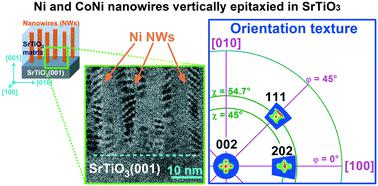当前位置:
X-MOL 学术
›
CrystEngComm
›
论文详情
Our official English website, www.x-mol.net, welcomes your feedback! (Note: you will need to create a separate account there.)
Orientation and lattice matching of CoNi nanowires embedded in SrTiO3: unveiling novel strain relaxation mechanisms in vertically aligned nanocomposites
CrystEngComm ( IF 3.1 ) Pub Date : 2020-06-22 , DOI: 10.1039/d0ce00574f Xiaorong Weng 1, 2, 3, 4, 5 , Marcel Hennes 1, 2, 3, 4, 5 , Thomas Tran 1, 2, 3, 4, 5 , Nicolas Casaretto 1, 2, 3, 4, 5 , Dominique Demaille 1, 2, 3, 4, 5 , Franck Vidal 1, 2, 3, 4, 5 , Yunlin Zheng 1, 2, 3, 4, 5
CrystEngComm ( IF 3.1 ) Pub Date : 2020-06-22 , DOI: 10.1039/d0ce00574f Xiaorong Weng 1, 2, 3, 4, 5 , Marcel Hennes 1, 2, 3, 4, 5 , Thomas Tran 1, 2, 3, 4, 5 , Nicolas Casaretto 1, 2, 3, 4, 5 , Dominique Demaille 1, 2, 3, 4, 5 , Franck Vidal 1, 2, 3, 4, 5 , Yunlin Zheng 1, 2, 3, 4, 5
Affiliation

|
Strain relaxation occurring during epitaxial thin film growth on lattice mismatched substrates has been studied extensively. However, it remains unclear whether existing concepts, developed to describe planar interfaces, still apply to vertically aligned nanocomposites (VANs). In these hybrid systems, which consist of nanowires (NWs) epitaxially coupled to a surrounding single crystal matrix, the structure of the vertical heterointerface is still terra incognita. In the present work, we study CoNi:SrTiO3 as a prototype VAN with large lattice mismatch between the oxide host and the embedded metallic phase. We show that the NWs display a variety of strain states: we identify NWs with huge average tensile strains (2.4 to 4.2%) along their [001] axis, as well as partially relaxed segments, with (101) and (111) planes almost parallel to those of the matrix. An additional relaxation mechanism is identified in Ni-rich VANs, where the rotation of parts of the NWs provides lattice matching for a set of (101) planes at the NW/matrix interface. Surprisingly, this tilting mechanism depends on the composition of the CoNi alloy. For high Co content (57% and 78%), the lattice matching with the matrix is along one set of (111) planes, with creation of (111) stacking faults, a behavior that can be attributed to the increasing influence of the fcc/hcp phase transition. This sheds light on the complex structural rearrangements at play in VANs and illustrates the fundamental differences between planar and vertical epitaxy in metal/oxide systems.
中文翻译:

嵌入SrTiO3中的CoNi纳米线的取向和晶格匹配:在垂直排列的纳米复合材料中揭示新颖的应变松弛机制
已经广泛研究了在晶格失配衬底上外延薄膜生长期间发生的应变松弛。但是,尚不清楚为描述平面界面而开发的现有概念是否仍适用于垂直排列的纳米复合材料(VAN)。在这些混合系统中,外延耦合到周围的单晶矩阵的纳米线(NW)组成,垂直异质界面的结构仍然是隐身的。在目前的工作中,我们研究CoNi:SrTiO 3作为原型VAN,在氧化物主体和嵌入的金属相之间具有较大的晶格失配。我们显示NW表现出各种应变状态:我们确定NW沿其[001]轴具有巨大的平均拉伸应变(2.4%至4.2%),以及部分松弛的段,几乎具有(101)和(111)平面与矩阵的平行。在富Ni的VAN中确定了另一种松弛机制,其中NW的部分旋转为NW /矩阵界面处的一组(101)平面提供了晶格匹配。出乎意料的是,这种倾斜机制取决于CoNi合金的成分。对于高Co含量(57%和78%),与矩阵的晶格匹配沿着一组(111)平面,从而产生(111)堆垛层错,这种行为可以归因于fcc / hcp相变的影响越来越大。这阐明了VAN中复杂的结构重排,并说明了金属/氧化物系统中平面外延和垂直外延之间的根本区别。
更新日期:2020-07-20
中文翻译:

嵌入SrTiO3中的CoNi纳米线的取向和晶格匹配:在垂直排列的纳米复合材料中揭示新颖的应变松弛机制
已经广泛研究了在晶格失配衬底上外延薄膜生长期间发生的应变松弛。但是,尚不清楚为描述平面界面而开发的现有概念是否仍适用于垂直排列的纳米复合材料(VAN)。在这些混合系统中,外延耦合到周围的单晶矩阵的纳米线(NW)组成,垂直异质界面的结构仍然是隐身的。在目前的工作中,我们研究CoNi:SrTiO 3作为原型VAN,在氧化物主体和嵌入的金属相之间具有较大的晶格失配。我们显示NW表现出各种应变状态:我们确定NW沿其[001]轴具有巨大的平均拉伸应变(2.4%至4.2%),以及部分松弛的段,几乎具有(101)和(111)平面与矩阵的平行。在富Ni的VAN中确定了另一种松弛机制,其中NW的部分旋转为NW /矩阵界面处的一组(101)平面提供了晶格匹配。出乎意料的是,这种倾斜机制取决于CoNi合金的成分。对于高Co含量(57%和78%),与矩阵的晶格匹配沿着一组(111)平面,从而产生(111)堆垛层错,这种行为可以归因于fcc / hcp相变的影响越来越大。这阐明了VAN中复杂的结构重排,并说明了金属/氧化物系统中平面外延和垂直外延之间的根本区别。



























 京公网安备 11010802027423号
京公网安备 11010802027423号